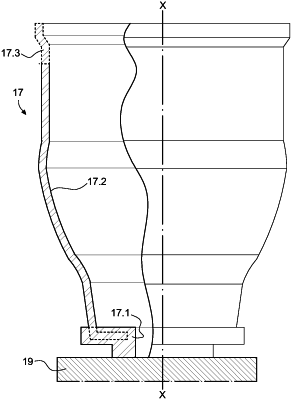| CPC B22F 12/30 (2021.01) [B22F 5/009 (2013.01); B22F 10/25 (2021.01); B22F 10/28 (2021.01); B22F 10/47 (2021.01); B33Y 10/00 (2014.12); B33Y 80/00 (2014.12); B22F 10/36 (2021.01); B22F 10/66 (2021.01); B22F 12/37 (2021.01); B22F 12/41 (2021.01)] | 12 Claims |

|
1. A method of making hollow turbomachine components using additive manufacturing, the method comprising:
producing a semi-finished component having an inner diameter by depositing material on a substrate to form portions of the semi-finished component in the following sequence:
a first terminal portion of the semi-finished component, the first terminal portion adhering to the substrate and forming a sacrificial flange;
an intermediate portion of the semi-finished component, the intermediate portion having a first end and a second end, the first end adjoining the first terminal portion, wherein the intermediate portion has a thickness that is less than the thickness of the sacrificial flange; and
a second terminal portion of the semi-finished component, the second terminal portion adjoining the second end of the intermediate portion and forming a stiffening feature in which the inner diameter of semi-finished component increases from a first diameter to a second diameter; and
removing the first terminal portion and t second terminal portion from the intermediate portion by,
cutting the semi-finished component at the first terminal portion to separate the semi-finished component from the substrate, thus forming a first free end of the semi-finished component that includes material of the first terminal portion; and
cutting the semi-finished component to separate the stiffening feature from the intermediate portion, thus forming a second free end of the semi-finished component; and
machining the semi-finished component on the first free end to create a thin flange that extends in a direction that is perpendicular to the longitudinal axis of the intermediate portion.
|